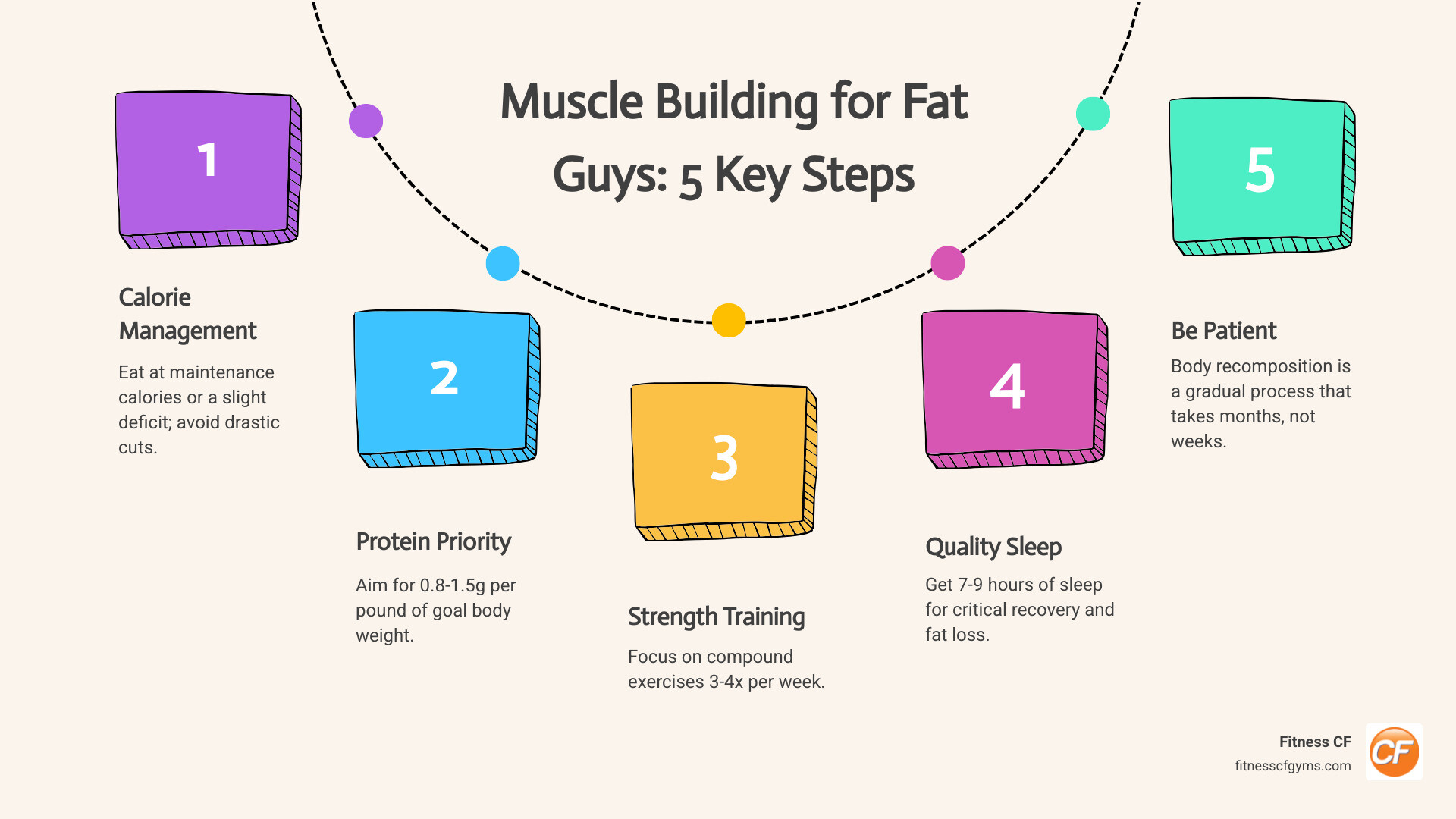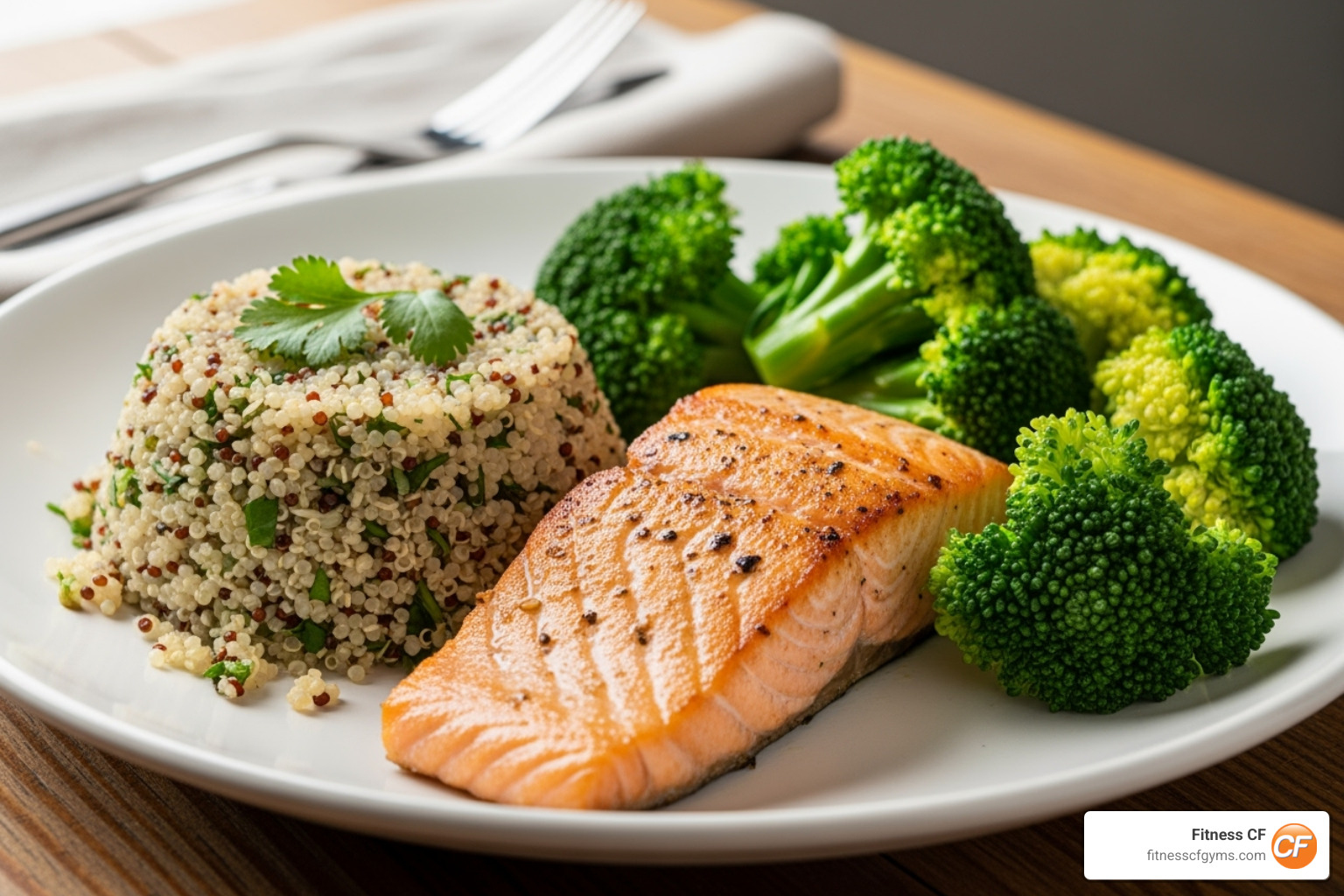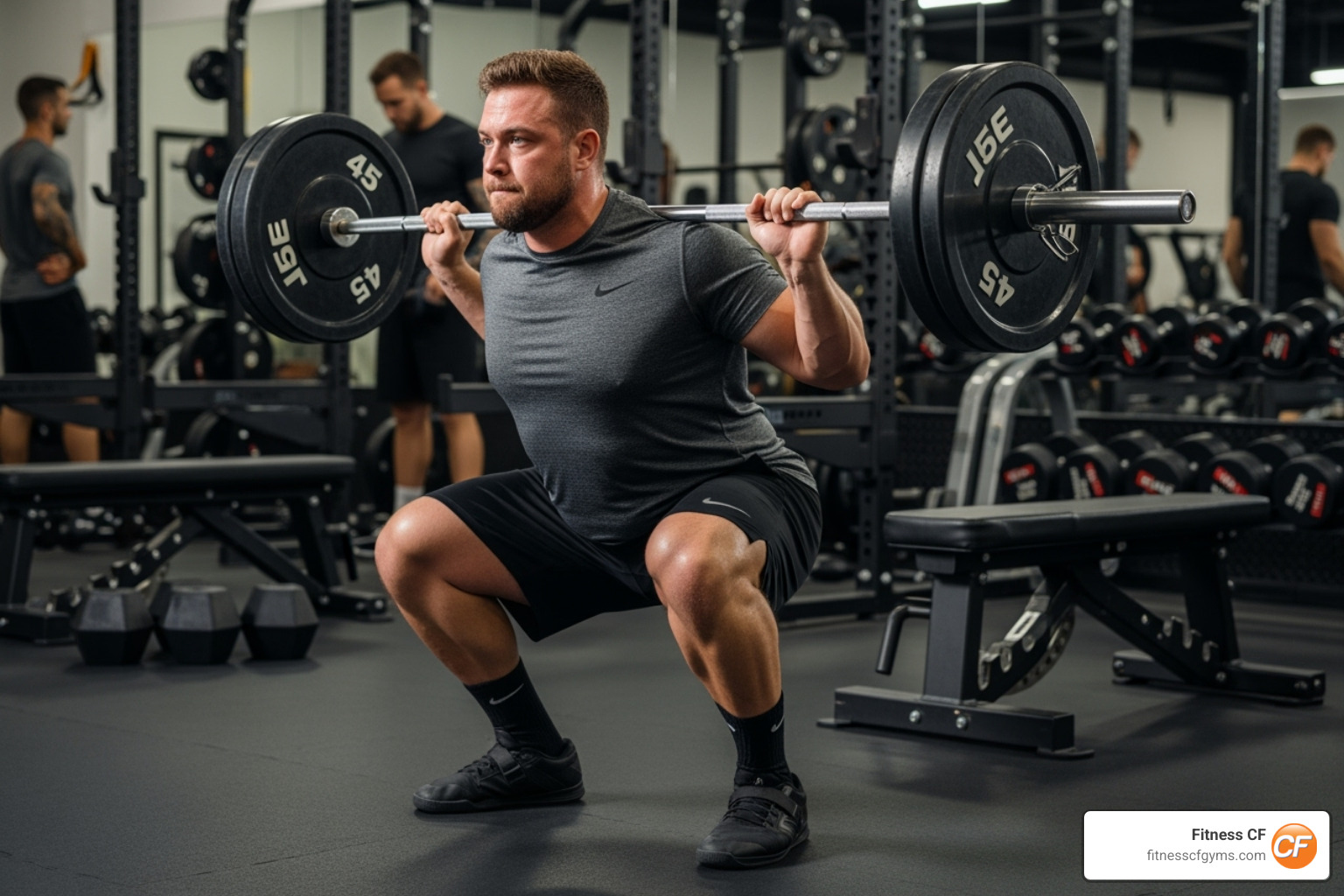Why Body Recomposition is Your Best Bet
Muscle building tips for fat guys can transform your physique through body recomposition—simultaneously losing fat while gaining muscle. This is highly effective for overweight individuals, as your body can use stored fat to fuel new muscle growth.
Quick Action Steps for Body Recomposition:
- Eat at maintenance or a slight deficit – Avoid drastic calorie cuts
- Prioritize protein – Aim for 0.8-1.5g per pound of goal body weight
- Focus on compound exercises – Squats, deadlifts, bench press, rows
- Train consistently – 3-4 strength sessions per week
- Get 7-9 hours of sleep – Critical for recovery and fat loss
- Be patient – Recomposition takes months, not weeks
Research confirms that individuals with higher body fat can build muscle in a caloric deficit. Studies show it’s possible to lose 3-5 pounds of fat monthly while gaining 1-2 pounds of muscle. Your stored body fat is an advantage, providing energy for muscle growth.
The key insight? You don’t have to choose between building muscle or losing fat. Body recomposition is the most efficient path to transform your physique.
I’m Pleasant Lewis, owner of Fitness CF with over 40 years in the fitness industry. My experience shows that body recomposition delivers lasting results when you focus on consistency and patience.

The “Recomp” Advantage: Why You Can Build Muscle and Lose Fat
Body recomposition is a straightforward and effective fitness concept: losing fat while building muscle simultaneously. Instead of traditional “bulking” and “cutting” cycles, this approach efficiently improves your body’s ratio of lean muscle to fat. It’s particularly effective if you have a higher body fat percentage, as your body can use its stored fat as energy to fuel new muscle growth. This process, known as “nutrient partitioning,” directs nutrients toward muscle building while using fat for fuel.
Furthermore, muscle is metabolically active, meaning more muscle mass increases the calories you burn at rest, creating a positive cycle for fat loss. Understanding your body composition provides a clearer picture of health than the scale alone. For a deeper dive, see this scientific research on body composition.
Is It Really Possible? Debunking the Myth
For years, the common belief was that you couldn’t build muscle and lose fat simultaneously, as one requires a calorie surplus and the other a deficit. However, this myth has been debunked, especially for those new to strength training or with higher body fat. This “beginner advantage” makes your body highly responsive to training, allowing for muscle growth even in a slight calorie deficit as it uses stored fat for energy.
Scientific evidence supports this. Studies show that a high-protein diet paired with strength training leads to simultaneous muscle gain and fat loss. You can explore evidence showing muscle gain in a calorie deficit for more information.
Renowned nutrition expert Alan Aragon suggests it’s possible to lose 3-5 pounds of fat monthly while gaining 1-2 pounds of muscle. This highlights why focusing on how you look and feel is more important than the number on the scale. Body recomposition is an achievable goal that requires patience and consistency, but the results are transformative.
Fueling the Change: Nutrition for Muscle Gain and Fat Loss
Nutrition is the cornerstone of body recomposition. The goal is not a drastic calorie cut, which can lead to muscle loss, but a slight caloric deficit or eating at maintenance. This allows your body to use stored fat for energy while still having enough fuel to build muscle. Learn more about Effective Weight Loss Strategies: Combining Exercise and Nutrition.
Focus on whole, unprocessed foods like fresh produce, lean proteins, and complex carbohydrates. These nutrient-dense foods keep you full and energized, helping you avoid the crashes associated with processed options.
Nutrition 101: Essential Muscle Building Tips for Fat Guys
Protein is your most important ally for building muscle. It provides the amino acids needed to repair and build new muscle tissue, and it helps protect your existing muscle mass when you’re in a calorie deficit. Research shows a diet high in protein can help facilitate fat loss while preserving lean mass.
Aim for 0.8 to 1.5 grams of protein per pound of your goal body weight daily. For a 200-pound goal weight, that’s 160-300 grams. Spread your intake throughout the day by including protein-rich foods at every meal.
Excellent high-protein sources include:
- Chicken breast
- Turkey breast
- Lean beef
- Eggs
- Lentils
- Cottage cheese
- Fish (like salmon, cod, or tuna)
- Greek yogurt
- Quinoa
- Tofu
The Role of Carbs and Fats

Carbohydrates and fats play crucial supporting roles. Complex carbohydrates like oats, brown rice, and sweet potatoes are your body’s primary fuel for workouts and are vital for muscle recovery. They provide sustained energy without the crash from simple sugars.
Healthy fats from sources like avocado, nuts, seeds, and fatty fish are essential for hormone production (including testosterone) and overall health. While calorie-dense, quality fats are a necessary part of a balanced diet. A well-rounded diet provides energy for workouts, protein for repair, and healthy fats and carbs for optimal function. Learn more in our Lean Muscle Diet: Your Complete Guide to Foods That Deliver.
Smart Supplementation
Supplements are meant to support an already solid diet and training plan, not replace them. A few can offer an edge in reaching your goals.
- Creatine: The most researched supplement for strength and muscle gain. It improves your body’s ability to produce energy during intense exercise. Studies show creatine increases strength, with a typical dose of 5 grams per day.
- Whey protein: A convenient way to meet high protein targets, especially post-workout or when you’re busy.
- Hydration: Don’t underestimate water. Even slight dehydration can impair performance and focus. Proper hydration is crucial for nutrient transport, temperature regulation, and joint health. Aim for at least a gallon of water daily.
The Ultimate Muscle Building Tips for Fat Guys: Training That Works

The right training approach is crucial for body recomposition. The foundation of muscle growth is progressive overload: consistently challenging your muscles to do more work over time. This can mean adding weight, reps, or sets, or decreasing rest time. Without this stimulus, muscles won’t grow. Learn more about Vitality Through Strength Training.
Consistency beats intensity. Three solid workouts a week is better than one extreme session that leaves you too sore to continue. A combined strategy of strength training and cardio is ideal for maximizing muscle gain and fat loss.
The Power of Strength Training
Strength training is non-negotiable for recomposition, as it signals your body to build and preserve muscle. Compound exercises are your most effective tool, working multiple muscle groups at once to stimulate growth and burn more calories. They are also highly functional, mimicking real-world movements. Explore the Best Strength Training Exercises to Add to Your Routine.
Key compound movements include:
- Squats: Works legs, glutes, and core.
- Deadlifts: Engages the entire back of the body (posterior chain).
- Bench Press: Targets chest, shoulders, and triceps.
- Overhead Press: Builds shoulder and tricep strength.
- Rows: Develops back muscles and biceps.
For muscle growth (hypertrophy), aim for 6-12 repetitions for 2-3 sets, taking sets close to failure while maintaining perfect form. Progress slowly, increasing weight by no more than 10% each week to ensure safety and consistent gains. For more, see How to Structure Lean Muscle Workouts.
The Smart Way to Do Cardio
Cardio accelerates fat loss and improves heart health, but it should support, not sabotage, your strength goals. See our comparison in Strength Training vs. Cardio: Which is Better for Weight Loss?.
While High-Intensity Interval Training (HIIT) is effective, it can be demanding on the joints for beginners. Brisk walking is an excellent alternative—a 20-30 minute walk aids fat loss without impeding muscle recovery.
Other low-impact options like cycling, swimming, or the elliptical are also great for burning calories while being gentle on your joints. Find more ideas in our guide to Low-Impact Workouts: Perfect for Beginners and Those with Joint Concerns.
The goal is to find a cardio balance that creates a calorie deficit and improves endurance without compromising your energy for strength training.
The Long Game: Consistency, Recovery, and Tracking Success
Body recomposition is a long-term lifestyle change that requires consistency and patience. It’s about building a healthier you from the ground up, not quick fixes. Celebrate small victories and focus on making sustainable changes over time. For more tips on long-term success, check out our guide on Becoming the New You: How to Burn Fat and Keep It Off.
The Critical Role of Recovery and Sleep

While workouts signal your muscles to grow, the actual repair and building happens during recovery. Skimping on rest slows progress and increases injury risk. Sleep is paramount, as it’s when your body releases growth hormone, which is essential for muscle repair. A 2019 study highlighted that sleep-deprived dieters lost significantly more muscle mass than fat compared to those who got adequate sleep. Aim for 7-9 hours of quality sleep nightly. Learn more from this study on sleep and body composition.
Rest days are equally crucial, allowing muscles to recover and strengthen. Active recovery, like a gentle walk or stretching, can aid this process. Managing stress is also key, as high cortisol levels can hinder muscle growth and promote fat storage.
Beyond the Scale: More Muscle Building Tips for Fat Guys on Tracking Progress
The scale can be misleading during body recomposition because muscle is denser than fat. You could lose 5 pounds of fat and gain 3 pounds of muscle, but the scale only shows a 2-pound loss. Focus on better indicators of progress:
- Progress photos: Take pictures every 4-6 weeks in the same lighting and pose to see visual changes.
- Body measurements: Use a tape measure for your waist, chest, arms, and thighs. A shrinking waist is a great sign.
- How your clothes fit: Looser clothing, especially around the waist, is a clear indicator of success.
- Strength gains: Logging your lifts and seeing the numbers increase is direct proof of muscle growth.
- Energy levels: Feeling more energetic, focused, and in a better mood are all positive signs of improved body composition.
Common Mistakes to Avoid
Knowing what to avoid is as important as knowing what to do. Steer clear of these common pitfalls, and for a deeper dive, see our guide on 11 Common Muscle Building Mistakes and How to Avoid Them.
- Overtraining: More isn’t always better. Training too often without adequate rest leads to fatigue and injury. Aim for 2-3 strength sessions per week.
- Under-eating: A drastic calorie cut can cause muscle loss. A slight deficit is effective for fat loss while preserving the fuel needed for muscle growth.
- Neglecting recovery: Insufficient sleep and skipping rest days will sabotage your efforts. Your body needs this time to rebuild.
- Poor form: Prioritize proper technique over lifting heavy. Bad form reduces effectiveness and significantly increases injury risk.
- Impatience: Body recomposition is a marathon, not a sprint. Expecting rapid results can lead to frustration and quitting.
- Relying on supplements: Supplements support a solid plan; they don’t replace it. Focus on nutrition, training, and sleep first!
Conclusion
We’ve explored how effective muscle building tips for fat guys make body recomposition an achievable reality. You can build muscle while shedding fat by leveraging your body’s stored energy.
Success hinges on a few key pillars:
- Strategic Nutrition: A high-protein diet with a slight calorie deficit, focusing on whole foods.
- Effective Training: A foundation of progressive overload using compound exercises, complemented by smart cardio.
- Prioritized Recovery: Ample sleep, rest days, and stress management are essential for muscle growth.
- Holistic Progress Tracking: Look beyond the scale to photos, measurements, strength gains, and energy levels.
Body recomposition is a journey of consistency and patience that transforms how you look and feel. The long-term benefits—better metabolic health, more energy, and improved quality of life—are profound. It’s about building a stronger, healthier you from the inside out.
For personalized guidance to tailor a program to your unique goals, consider working with a professional. Our certified personal trainers can help you steer this exciting path. Explore our Personal Training options and take the first step toward your change today.







